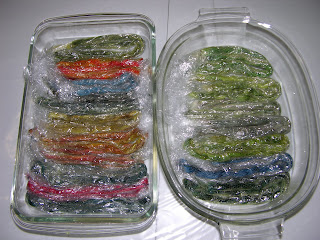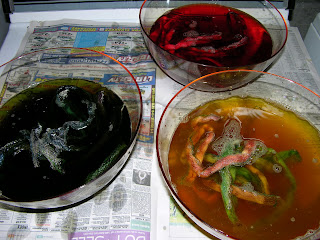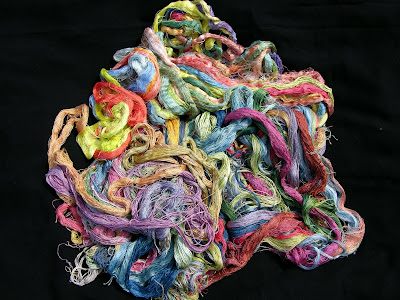














This is the chronicle of ongoing summer experiences dyeing my own embroidery threads for Wisconsin winter cross-stitching. It's been an adventure. C'mon along, and let me share the story with you!

























Whew. Enough with the lists, with the procedures, with the blah blah blah. Let's not forget why we're all here. Before we plunge into the actual dyeing, I want to remind us all why we're doing this. Here's some eye candy, some unabashed show and tell of completed work so far this summer.
This is about 2/3 of my cotton floss to date,
ironed and skeined.

And this is my silk,
unironed and unskeined.
(I decided I had autumn to do that part, and
ought to concentrate on the dyeing.)

This isn't brain surgery, friends. It's all produced via simple materials and procedures, using dyes that are marketed as ideal for children to use. You need not be an artist or a scientist to make beautiful threads for yourself. And when you've accomplished this, you will have, in addition to a spectacular stash, some wonderful currency for bartering! Take five of your thirty-yard cotton skeins and break each down into six five yard skeins. Now you have six complete sets of five different colored skeins. You've seen, and will see here some simple weaving equipment put to good use. Make friends with a weaver! Borrow her warping board or umbrella swift, or niddy-noddy for the weekend to prepare your threads, and return it/them with an array of colorful skeins for her own embroidery as a thank-you gift.
Struggle to shop for goodies to include with your cross-stitch exchanges? What about skeins of your own threads? Use your computer's word processing program to design and print lovely hang tags for them: "Threads by (whomever)." Are you familiar with Fish Pepper? Soot? Deadly Nightshade? Apply your own lovely evocative names to the colors you've created and write them on your hang tags.
Ready? Enthused? Let's dye.











We have a small septic system here at our summer place, and I don't pour colored rinse water into it. I thought I was being careful ferrying buckets of rinse water up the basement stairs to dump outside, but the work has been exciting and I was really cranking out the finished product; I hurt my back with the multiple trips. Rats. That has slowed production, I'm afraid.
I've been working on cotton floss, striving to produce colors with subtle variations along the lines of the Weeks Dye Works floss. The final steps in the process are all done rather blindly, and it's hard to tell what you have until the last step, when the finished floss is ironed and skeined, and only then you can see how the subtle striations of color travel through the threads. It's hard to tamp down the urge to pursue the task aggressively until my back feels better.